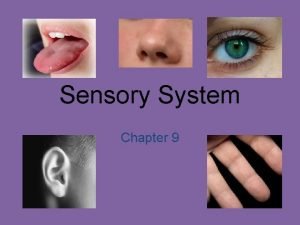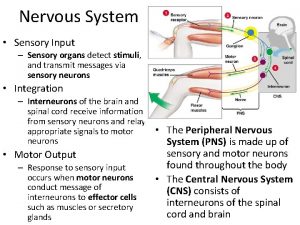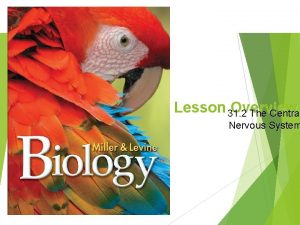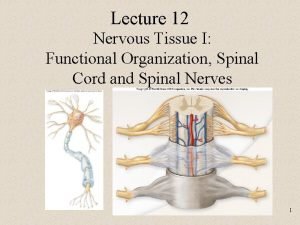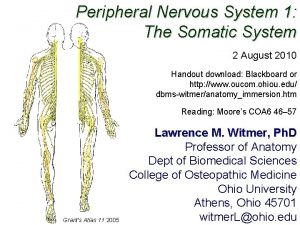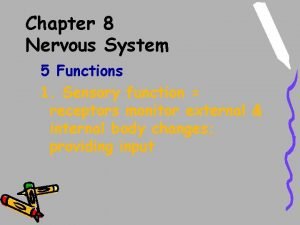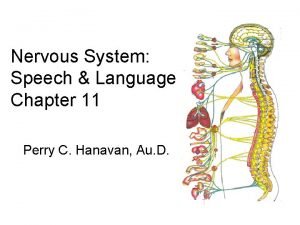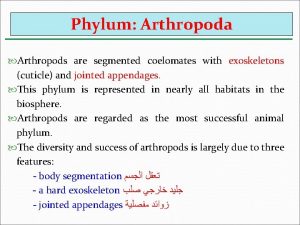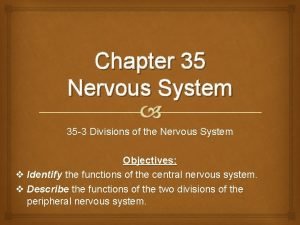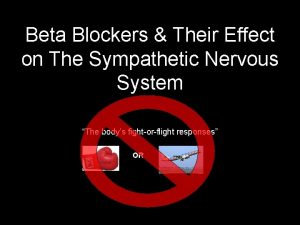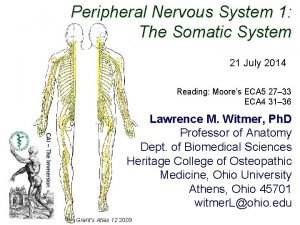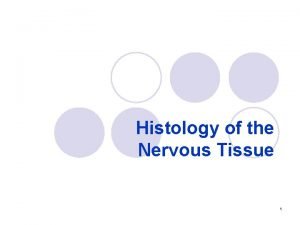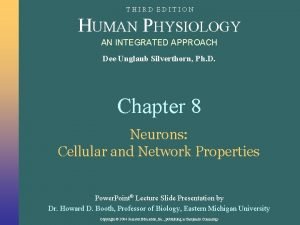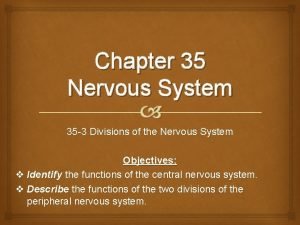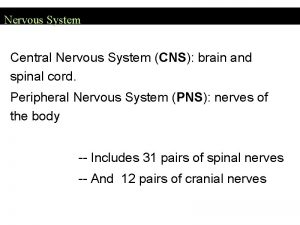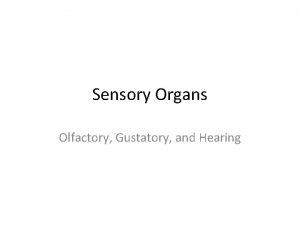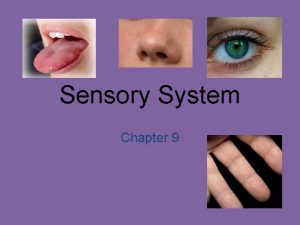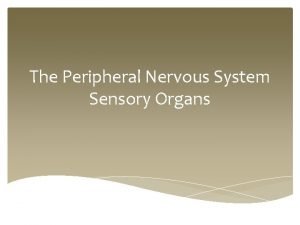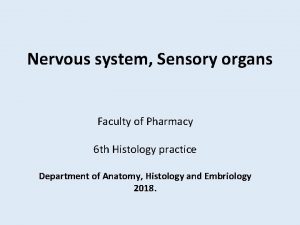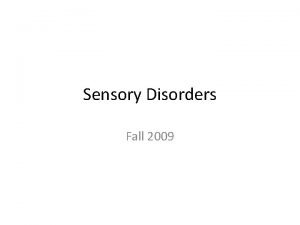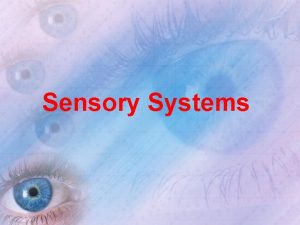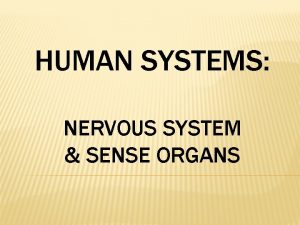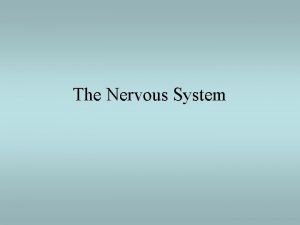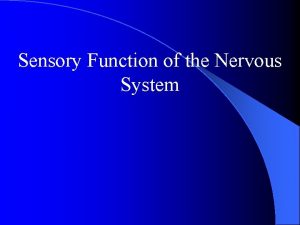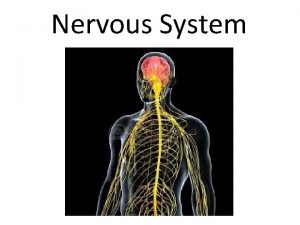The Sensory Organs The Sensory Organs The nervous





































- Slides: 37

The Sensory Organs

The Sensory Organs • The nervous system receives information about the outside world from the sensory organs: • • • The Nose (smell – scents/odours) The Tongue (taste – tastes) The Ear (hearing – sound waves) The Skin (touch – pressure, temperature, pain) The Eye (vision – light, color)

1 - The Nose • The nose contains olfactory receptors that detect a variety of odours, then send a nerve impulse to the brain along the olfactory nerve

The Nose

The Nose Olfactory Epithelium Small, (5 cm²), location where the nerve cells related to smell are found. Olfactory Bulb Located above the nasal cavity, this bulb transmits odour information into nerve impulses. Olfactory Nerve responsible for the transmission of odour nerve impulses to the brain.

2 - The Tongue • The tongue reacts to four tastes (bitter, sour, salty, sweet) • The taste buds respond to a taste and then send a nerve impulse to the brain along sensory nerves

The Tongue • The tongue is a sensory receptor related to taste. • The tongue is covered in papillae, (one papilla), and within each are the taste buds. • There are three nerves that carry nerve impulses created by the taste buds to the brain. • There are 5 tastes that humans can detect: • Sweet, sour, salty, bitter and umami.

The Tongue

How The Tongue Works • All taste buds experience all five tastes, regardless of their position on the tongue. • Taste and smell work together. The taste itself only accounts for about 10% of the taste experience. This is because the smell of food often helps us to identify what we are eating. • Other tongue receptors distinguish temperature, discomfort, (prickly feeling), and the textures of foods.

3 - The Ear • The ear responds to sound waves from the outside world • Sound waves are generated by the vibration of objects • Sound waves have the ability to travel through matter, though some insulating materials will absorb sound waves • The ears pick up sounds and convert them into nerve impulses.

Sound Waves • A sound wave has certain characteristics: • Frequency (or pitch): the number of cycles or waves per second crossing a given point (the human ear can detect between 16 cycles per second and 28 000 cycles per second) • Wavelength: the length from one crest to another of a wave • Amplitude: the loudness of the wave • Amplitude is commonly measured in decibels (named for Alexander Graham Bell)

Sound Waves – Amplitude & Wavelength

Sound Waves - Frequency

Sound Waves – Decibel Scale Source Intensity Level Threshold of Hearing (TOH) 0 d. B Rustling Leaves 10 d. B Whisper 20 d. B Normal Conversation 60 d. B Busy Street Traffic 70 d. B Vacuum Cleaner 80 d. B Large Orchestra 98 d. B Walkman at Maximum Level 100 d. B Front Rows of Rock Concert 110 d. B Threshold of Pain 130 d. B Military Jet Takeoff 140 d. B Instant Perforation of Eardrum 160 d. B

Above 120 d. B – instant damage 100 d. B - 15 minutes to damage 85 d. B - 8 hours to damage 112 d. B – 1 minute to damage 97 d. B – 30 minutes to damage

Anatomy of the Ear • The ear is divided into three major sections: • • • The Outer Ear The Middle Ear The Inner Ear

The Ear

Structure Description The visible part of your ear. It is The Parts of the funnel shaped. Ear so as to pick up sound Pinna vibrations from the air. Auditory Canal Slightly curved, 2. 5 cm long Canal that carries sound vibrations to the eardum. It is lined with hairs and sebaceous glands that produce wax, preventing debris from entering the ear. Tympanic Membrane The eardrum. It is a thin, flexible membrane that moves to the rhythm of sound vibrations. Ossicles, (bones) Miniature bones located in the temporal bone. The three, the hammer, the anvil and the stirrup, move in relation to one another. Eustachian Tube Canal that links the middle ear to the pharynx. It equalizes pressure on either side of the eardrum during swallowing. Outer Ear Middle Ear

Structure Description Semi-Circular Tubes Canals that are filled with liquid. They regulate balance when the body is in motion and are linked to the vestibular nerve. Vestibule Liquid-filled structure that links the semi-circular canals to the cochlea. Plays a role in balancing the body when not in motion and is also linked to the vestibular nerve. Cochlea Liquid-filled structure whose walls are covered with auditory neurons and are linked to the auditory nerve. This is where sounds get transmitted from neurons to send to the brain. Inner Ear

The Outer Ear • The Auricle • The visible part of the ear • Receives and filters sound waves and directs them to the auditory (ear) canal • The Auditory Canal • A tube lined with fine hairs and glands that secrete cerumen (ear wax) • Carries sound waves to the ear drum

The Middle Ear • The Ear Drum • A thin membrane that vibrates when struck by sound waves • The Ossicles • Three small bones (the hammer, the anvil and the stirrup) that vibrate in response to the vibration of the ear drum • They sometimes amplify the vibrations • The Eustachian tube • A tube connecting the ear to the pharynx (throat) • Important to balance the air pressure on both sides of the ear drum

The Inner Ear • The Semi-Circular canals • Fluid-filled canals that provide information to the cerebellum about the position and movement of the head • The Cochlea • Receives and transforms the vibrations coming from ossicles into a nerve impulse to be sent to the cerebrum

Nerves of the Ear • The Vestibular Nerve • Carries the nerve impulse from the semi-circular canals to the cerebellum to help with balance • The Auditory Nerve • Carries the nerve impulse from the cochlea to the cerebrum to allow us to hear

How the Ears Work ∗ Sounds are created by vibrations in the air. Sound waves cause changes in the air pressure surrounding us, creating sound waves that our ears can pick up. ∗ Sound waves are channeled by the pinna and sent down the auditory canal until they reach the cochlea. ∗ In the cochlea, the sound vibrations are transformed into nerve impulses and sent to the brain via the auditory nerve. ∗ In the brain, these nerve impulses are analyzed, causing us to hear.

How the Ears Work • THE PATH OF SOUND • Sound vibrations reach the eardrum, causing it to vibrate. • This sets the ossicles in motion. The stirrup transmits the vibrations to the vestibular canal. • After passing this canal, vibrations are sent to the cochlea, which transmits the vibrations into nerve impulses. • Nerve impulses travel via the auditory

The Ear – Another Role ∗ The ear also plays an important role in our balance. ∗ The ossicles, (hammer, anvil and stirrup), are each responsible for knowing when our heads are tilting, moving from side to side, or up and down. ∗ The ossicles are activated by the small hairs that they have. When the fluid within them moves, it activates the hair cells. ∗ They can then situate our bodies by sending nerve impulses from the vestibular nerve to the brain. ∗ This is why we know where we are in space, and why we don’t fall down when we walk, dance, play sports, etc…

4 - The Skin • The skin is the sensory organ associated with touch. • This is the bodies largest organ, as it covers the entire surface of the body. • Skin has three distinct layers: the epidermis, the dermis and the hypodermis.

The Skin

The Skin Layer Structures Description Dead Layer Outer skin layer. Atmospheric pressure causes these skin cells to die. Living Layer of constantly dividing cells, (mitosis). New cells push older cells to the surface. Sensory Receptors Structures that pick up stimuli, (pressure, heat/cold). Blood Vessels that nourish the skin cells with oxygen and nutrients. Sebaceous Glands that secrete sebum, and oily substance that keeps skin waterproof. Sweat Glands that produce sweat, carried to the skin surface through pores. Hair Arise from the dermis and protrude out of the skin. Epidermis Dermis Layer of fat-containing cells that act as an

How The Skin Works • The sensory receptors, (neurons), in the skin allow us to experience: • Tactile sensations, (touch, pressure). • Thermal sensations, (heat and cold). • Painful sensations • The nerve endings in the skin are either free or protected and each one is responsible for different stimuli. • The different sensory receptors are not equally spread out in the body. This is why parts of our bodies experience more pain than others, and why some are more sensitive to cold.


5 - The Eye • The eye is the sensory organ related to vision. • It detects light variations, colours, and can adapt to light intensity. • Normal eyes can differentiate 2, 000 colours.

The Eye

The Parts of the Eye Sclera • Rigid, opaque membrane of the eye. Protects the eye from shock and gives it shape. The white part. Choroid Middle layer of the eye. Blood vessels connect here to nourish the eye. Retina Innermost layer at the back of the eye. Covered in millions of lightsensitive nerve cells that transform incoming data into nerve impulses. Cornea Clear and rigid membrane that is an extension of the sclera Iris The extension of the choroid. This membrane is pigmented, giving eyes colour. There is an opening that regulates the amount of light entering. Lens Flattened sphere that focuses light information on the retina. The part we can see is the pupil. Aqueous humour Transparent liquid that fills the space between the cornea and the lens. Vitreous humour Transparent jelly-like substance that fills the space between the lens and the retina.

How the Eye Works • The lens of the eye works similar to a camera lens. It can adjust its size so as to see things at different distances. • When objects are at a distance, the lens flattens. When they are up close, the lens is rounded. • Once colours and light enter the eye, the retina converts the information into nerve impulses, and sends it from neuron to neuron until it reaches the brain. • Information is sent from the optic nerve, ultimately to the brain. • The brain analyzes the information and allows us to make judgements on the colours that we see, the distances of things, their shapes and their relative sizes.

How the Eye Works

How the Eye Works • Nerve cells on the retina convert light and colours into nerve impulses. • Some of the nerve cells are called cones. • Only able to distinguish colours. • Other nerve cells are called rods. • Only distinguish variations in light intensity. • Nerve impulses from the retina are transmitted through the optic nerve and sent to the brain. The brain superimposes the images from each eye into one image
 Neuronal pools are collections of
Neuronal pools are collections of Neuronal pool
Neuronal pool Fundamentals of the nervous system and nervous tissue
Fundamentals of the nervous system and nervous tissue Sensory system organs
Sensory system organs Organs of the sensory system
Organs of the sensory system Comparison of endocrine and nervous system
Comparison of endocrine and nervous system Nervous system
Nervous system Nervous system structure
Nervous system structure Body system amusement park project
Body system amusement park project Functional nervous system
Functional nervous system Dermatome map
Dermatome map Somatic and autonomic nervous system
Somatic and autonomic nervous system Enteric plexus
Enteric plexus Neuroglia
Neuroglia Major divisions
Major divisions Peripheral nervous system consists of
Peripheral nervous system consists of 5 functions of the nervous system
5 functions of the nervous system Nervous system speech
Nervous system speech Segmented coelomates
Segmented coelomates Percy jackson chapter 11 pdf
Percy jackson chapter 11 pdf Adrenal gland sympathetic nervous system
Adrenal gland sympathetic nervous system Chapter 35 nervous system
Chapter 35 nervous system Classification of nervous system
Classification of nervous system Nervous system
Nervous system Sns pg
Sns pg Beta-blockers for overactive sympathetic nervous system
Beta-blockers for overactive sympathetic nervous system Labelled diagram of platyhelminthes
Labelled diagram of platyhelminthes Dermatome map
Dermatome map Chapter 15 nervous system diseases and disorders
Chapter 15 nervous system diseases and disorders Autonomic dysreflexia
Autonomic dysreflexia Nervous tissue definition
Nervous tissue definition Nervous
Nervous 35-3 divisions of the nervous system
35-3 divisions of the nervous system Coccygeal spinal nerves
Coccygeal spinal nerves Cns histology ppt
Cns histology ppt Brain parts
Brain parts Nervous system in coelenterates
Nervous system in coelenterates Spinal cord structures
Spinal cord structures



